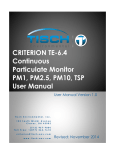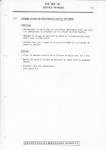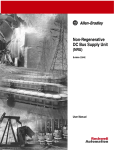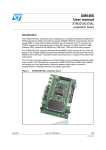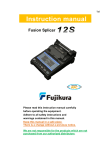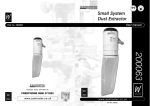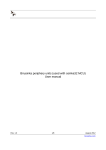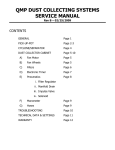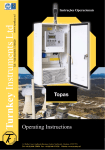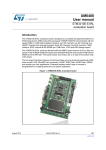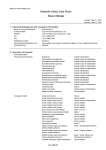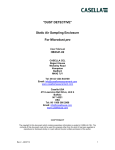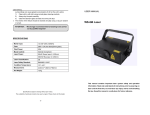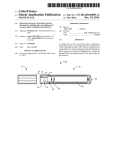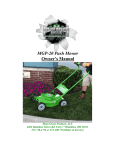Download TE-6.5 Series Criterion Particulate Spectrometer Analyzer Manual
Transcript
CRITERION TE-6.5 Portable Continuous Particulate Monitor User Manual User Manual Version 1.0 Tisch Environmental, Inc. 145 South Miami Avenue Cleves, OH 45002 (513) 467-9000 Toll Free: 1(877) 263-7610 [email protected] www.tisch-env.com Revised: November 2014 0 Criterion TE -6.5-Portable Continuous Particulate Monitor User Manual 1 .0 This page is intentionally blank 1 Criterion TE -6.5-Portable Continuous Particulate Monitor User Manual 1 .0 Table of Contents Table of Contents .............................................................................................................................................................. 2 Manufacturer’s Statement ................................................................................................................................................ 4 Notice ................................................................................................................................................................................ 4 Safety Requirements ......................................................................................................................................................... 5 Warranty ........................................................................................................................................................................... 5 Service & Repairs .............................................................................................................................................................. 6 Claims for Damaged Shipments and Shipping Discrepancies ............................................................................................ 7 Internationally Recognized Symbols on Tisch Environmental Equipment ........................................................................ 8 TE‐6.5 – Keypad Quick Reference ..................................................................................................................................... 9 1. TE‐6.5 and AirQ for Windows ........................................................................................................ 10 1.1 Installation of Air32Q .......................................................................................................................................... 10 2. GETTING STARTED WITH TE‐6.5 .................................................................................................... 12 3. TE‐6.5 EDITOR ................................................................................................................................ 14 4. Editing with AirQ ............................................................................................................................ 20 5. TE‐6.5 Manual Sampling Mode ...................................................................................................... 22 6. Remote Sampling with AirQ .......................................................................................................... 24 7. Sampling with the TE‐6.56.5 – How Does It Work? ....................................................................... 26 8. Uploading Stored Results .............................................................................................................. 28 9. Maintenance .................................................................................................................................. 30 Appendix A – Table of Recording Times ................................................................................................ 34 Appendix B – Technical Specification .................................................................................................... 36 Appendix C – Collection Efficiencies ...................................................................................................... 38 Page 2 This page is intentionally blank Page 3 C r i te r io n TE -6. 5 -Po r ta b le C o n t in u o u s P a r ti c ul a te Mon i to r U se r M a n ua l 1 . 0 Manufacturer’s Statement Thank you for selecting the Tisch Environmental Criterion TE‐6.5‐Portable Continuous Particulate Monitor. The Criterion series is the next generation of Tisch Environmental gas analyzers. This User Manual provides a complete product description including operating instructions, calibration and maintenance requirements for the Criterion TE‐6.5‐Portable Continuous Particulate Monitor. This manual is valid for the most recent version of the Criterion TE‐6.5‐Portable Continuous Particulate Monitor. Reference should also be made to the relevant local standards which should be used in conjunction with this manual. Some of these standards are listed in this manual. If, after reading this manual you have any questions or you are still unsure or unclear on any part of the Criterion TE‐6.5‐Portable Continuous Particulate Monitor please do not hesitate to contact Tisch Environmental or your local Tisch Environmental distributor. Please help the environment and recycle the pages of this manual when you have finished using it. Notice The information contained in this manual is subject to change without notice. Tisch Environmental reserves the right to make changes to equipment construction, design, specifications and/or procedures without notification. Copyright © 2014. All rights reserved. Reproduction of this manual, in any form, is prohibited without the written consent of Tisch Environmental, Inc. Page 4 CAUTION Hazardous voltages exist within the instrument. Do not remove or modify any of the internal components or electrical connections while the main power is on. Ensure the main power lead is maintained in a safe working condition. The instruments lid should be closed during normal operation to comply with EMC regulations. Safety Requirements To reduce the risk of personal injury caused by electrical shock, follow all safety notices and warnings in this documentation. If the equipment is used for purposes not specified by Tisch Environmental, the protection provided by this equipment may be impaired. Replacement of any part should only be carried out by qualified personnel, using only parts specified by Tisch Environmental as these parts meet stringent Tisch Environmental quality assurance standards. Always disconnect the power source before removing or replacing any components. Warranty The product is subject to a 12‐month warranty on parts and labor from date of shipment. The warranty period commences when the product is shipped from the factory. Lamps, filters and other consumable items are not covered by this warranty. Each instrument is subjected to a vigorous testing procedure prior to despatch and will be accompanied with a parameter list and a multipoint precision check, thereby enabling the instrument to be installed and ready for use without any further testing. Page 5 Criterion TE -6.5-Portable Continuous Particulate Monitor User Manual 1 .0 Service & Repairs Our qualified and experienced technicians are available to provide fast and friendly service between the hours of 8:00 a.m. – 5:00 p.m. EST Monday to Friday. Please contact Tisch Environmental regarding any questions you have about your instrument. Service Guidelines This manual is designed to provide the necessary information for the setup, operation, testing, maintenance and troubleshooting of your instrument. Should you still require support after consulting the documentation, we encourage you to contact your local distributor for support. To contact Tisch Environmental directly, please e‐mail our Technical Support Services group at criterion@tisch‐env.com. To speak with someone directly: Please dial 1‐877‐263‐7610 (toll free), or (513) 467‐9000. Please contact Tisch Environmental and obtain a Return Material Authorisation (RMA) number before sending any equipment back to the factory. This allows us to track and schedule service work and to expedite customer service. Please include this RMA number when you return equipment, preferably both inside and outside the shipping packaging. This will ensure you receive prompt service. When shipping instrumentation, please also include the following information: Name and phone number Company name Shipping address Quantity of items being returned Model number/s or a description of each item Serial number/s of each item (if applicable) A description of the problem and any fault‐finding completed Original sales order or invoice number related to the equipment Shipping Address: Attention: Criterion Service Department Tisch Environmental, Inc. 145 South Miami Avenue Cleves, OH 45002, United States of America. Page 6 Claims for Damaged Shipments and Shipping Discrepancies Damaged Shipments Inspect all instruments thoroughly on receipt. Check materials in the container/s against the enclosed packing list. If the contents are damaged and/or the instrument fails to operate properly, notify the carrier and Tisch Environmental immediately. The following documents are necessary to support claims: Original freight bill and bill of lading Original invoice or photocopy of original invoice Copy of packing list Photographs of damaged equipment and container You may want to keep a copy of these documents for your records. Please refer to the instrument name, model number, serial number, sales order number and your purchase order number on all claims. You should also: Contact you freight forwarder for an insurance claim Retain packing material for insurance inspection Shipping Discrepancies Check all packages against the packing list immediately on receipt. If a shortage or other discrepancy is found, notify the carrier and Tisch Environmental immediately. Tisch Environmental will not be responsible for shortages against the packing list unless they are reported within seven days. Contact Details Tisch Environmental, Inc. 145 South Miami Avenue, Cleves, OH 45002, United States Phone: 1‐877‐263‐7610 (toll free), or (513) 467‐9000 Email: criterion@tisch‐env.com www.tisch‐env.com Page 7 C r i te r io n TE -6. 5 -Po r ta b le C o n t in u o u s P a r ti c ul a te Mon i to r U se r M a n ua l 1 . 0 Internationally Recognized Symbols on Tisch Environmental Equipment Protective conductor terminal IEC 60417‐5017 Alternating current IEC 60417‐5032 Caution, hot surface IEC 60417‐5041 Caution, risk of danger. Refer to accompanying documents Caution, risk of electric shock ISO 3864‐5036 Page 8 ISO 7000‐0434 TE‐6.5 – Keypad Quick Reference KEY‐PRESS FUNCTION to switch on [ON] to quit editing [RESET] to see battery condition & location [EDIT] to select the TE‐6.5 Editor [ENTER] to select an operation or confirm a response to enter the changes made during editing to start or stop sampling [START] to clear memory [STOP] to review stored results to clear a value during editing [] to increase a value to say YES [] to decrease a value to say NO [NEXT] to go to the next item or display Page 9 Criterion TE -6.5-Portable Continuous Particulate Monitor User Manual 1 .0 1. TE‐6.5 and AirQ for Windows The TE‐6.5 environmental monitor can be supplied with AirQ32 for Windows software. This enables results stored in the TE‐6.5 memory to be uploaded into your PC when you have completed sampling. Additionally your PC can be used to control and collect results from the TE‐6.5 sensor in real time. AirQ is designed to collect, manage and display data from a range of environment sensors, either as individual sensors or in real‐time when connected to a sensor network. The sensors can be used to measure a whole range of environmental quantities such as PM10 particles, airborne fibers, VOCs and pollutant gases. AirQ is provided with extensive on‐line help with hypertext links, clicking an on‐screen button with a blue question mark will automatically open the relevant help page. 1.1 Installation of Air32Q The program is supplied on CD and requires Windows 95 or above to operate. An un‐installer is provided with the program. Approximately 20 MB of free disk space is required on drive C: to complete the installation. To install in Windows: Insert the CD it should launch automatically if not run setup.exe, then follow the on‐screen instructions. AirQ32 will be installed in C:\Airq32. Sample results which can be imported, if required, are to be found in C:\Airq32\Examples. Page 10 This page is intentionally blank TE‐6.5 and AirQ for Windows Page 11 Criterion TE -6.5-Portable Continuous Particulate Monitor User Manual 1 .0 2. GETTING STARTED WITH TE‐6.5 Before starting the TE‐6.5, connect a fully‐charged battery pack via the 6‐pin DIN connector. SWITCHING ON: To turn the instrument on, press and release the switch marked [ON]. After a short self‐test (see SELF TEST below) the display will show "TE‐6.5 ready", together with the time and date. If the battery needs re‐charging, the display will show “TE‐6.5 paused” and continuously flash “Charge battery”. The battery must be fully re‐charged as soon as the “Charge battery” warning appears. SWITCHING OFF: Providing the instrument is not sampling it will switch itself off automatically if no buttons have been pressed for 4 minutes. To manually switch off the instrument press [] and [] together. TE‐6.5 will not switch itself off while on‐line to AirQ. DISPLAY CONTRAST: To adjust the contrast of the display press and hold [RESET] as the instrument is switched‐on until the display goes black after about 3 seconds. Then use the [] or [] buttons to darken or lighten the display respectively. Press [ENTER] when the required contrast is obtained. TE‐6.5 will automatically remember this setting and use it each time it is switched‐on. The contrast can only be adjusted as you switch the instrument on, and once set it should not normally need re‐ adjusting. SELF TEST: Page 12 As TE‐6.5 is switched on it carries out certain self‐tests to make sure it is working correctly. At the end of the self‐test the display will show "Last Serviced at", this is the time and date when the instrument was serviced. If this is more than a year ago, the display will show "PLEASE HAVE ME FACTORY SERVICED" instead. If the instrument detects a fault with its memory during the self‐test the display will show "MEMORY ERROR". If the instrument has a potential fault the display will show "INSTRUMENT FAULT". In both of the above cases, the instrument will automatically revert to its default settings and may still be usable ‐ albeit with reduced accuracy. After the error message, the display will show "PLEASE HAVE ME FACTORY SERVICED". In this case please contact the factory as soon as possible. MEMORY: If you press [RESET] while the display shows "TE‐6.5 ready" or during sampling, the display will switch to indicating the battery voltage, internal case temperature, and the percentage of memory used. Release [RESET] to revert to the normal display. During sampling, when [RESET] is released, the display will first show the sample number and instrument location. The fully charged battery voltage is about 6.4 volts (charger disconnected). It is suggested that the battery is recharged if its voltage drops below 5.9 volts. Sampling will cease automatically and the display will indicate “TE‐6.5 paused” if the battery drops below about 5.8 volts. Sampling will also cease if the case temperature exceeds 50°C. As the percentage of memory used approaches 100% you should cease sampling as soon as possible and transfer your results to a PC. There is some leeway here, for the memory is only truly full when the indicator shows 120%. Sampling will cease automatically and the display will indicate “TE‐6.5 paused” if the end of the memory is reached. The battery charger should be connected to the 8 pin DIN connector on the battery pack. When the battery charger is connected, the battery voltage will eventually rise to about 7.25 volts. The battery pack can be charged without the instrument. GETTING STARTED WITH TE‐6.5 Page 13 Criterion TE -6.5-Portable Continuous Particulate Monitor User Manual 1 .0 3. TE‐6.5 EDITOR The TE‐6.5 Editor allows some of the instrument settings and parameters to be changed. To select the editor press [EDIT] while the display shows "TE‐6.5 ready" or during dust sampling, then use [NEXT] to select what to edit followed by [ENTER] to select. Note that during sampling the number of items which can be edited is restricted. When your instrument is connected to your PC, the settings and parameters can also be changed via the AirQ Configuration Window. Please refer to the next section for details. Set Dust Alarm: allows you to set the dust concentration at which the alarm will operate (Only available when the alarm is enabled). The alarm operates on the average reading on the Total Particles (Inhalable) channel during the display interval and is expressed as a percentage of the instrument’s alarm scale. On the microgram range the alarm scale is 1000 micrograms, so a 01.00% alarm (default) corresponds to 10 micrograms per cubic meter dust concentration. On the milligram range the alarm scale is 10 milligrams, so a 01.00% alarm corresponds to 0.1 milligrams per cubic meter dust concentration. The default alarm setting is 01.00% of scale. Press [] or [] to change the flashing digit then [NEXT] to move on to the next digit position. Press [ENTER] to quit and save the revised entry. Press [RESET] to quit without saving. Press [START] to reset the calibration factor to 1.00. Zeroing Interval: allows the user to select the time intervals when auto‐zeros will carried out. The range is 0 hour to 240 hours. The instrument automatically zeros itself when starting to sample and thereafter "on‐the‐hour" at the interval shown on the LCD. If the interval is set to 0 hours, no further zeroes are carried out. Auto‐zeros last for about 5 seconds during which time the pump is switched off. The default interval is 1 hour. The previous reading is held during auto‐zeros. Press (and hold to speed up) [] or [] to change the interval then press [ENTER] to save the revised value. Results Display: allows the user to select which results will be displayed on the LCD during sampling. The selection can be changed during sampling. The available options are: Backlighting: select YES to turn on the display backlight for viewing in poor light. The extra power used will reduce the total sampling time on internal batteries by about 30%. Note backlighting can also be controlled via AirQ. Display Cycling: select YES if you want the display to automatically scan around the available results channels. If you select NO then, during sampling, the results channel shown on the LCD can be changed manually using [NEXT]. Page 14 Latest Dust: select YES if you want the display to show the latest particle concentration. This will be the time weighted average over the Display Refresh interval. Average Dust: select YES if you want the display to show the average particle concentration since the sampling started. Note that average results are only available after the first results have been saved in memory (i.e. after the storage interval). Display Refresh: allows the user to select the time interval at which results display is updated. The range is 1 second to 240 seconds. The value displayed on the LCD will be the average reading taken over this interval. Press (and hold to speed up) [] or [] to change the interval then press [ENTER] to save the revised value. Filter & AirFlow: pressing [ENTER] shows the time and date the filter was last changed, and the sampling time in minutes it has been used up to a maximum of 65536 minutes (45.5 days). Press [RESET] to display the total mass of dust the instrument (based on its current calibration factor and a flow rate of 600ml/min) thinks it has accumulated (over all samples) on its filter. This is a useful aid to calibration. Press [RESET] to display the total operating time of the pump in hours. Press [RESET] again and you are prompted to change the filter, press [ENTER] followed by the password [START] [START] [START] to do so. The filter timer and filter mass accumulator (but not the pump time accumulator) will be automatically reset at this time. If you do not wish to change the filter, just press [RESET]. You will then be prompted to set the sample air flow to its correct value. Connect a 4 mm OD plastic tube and flow meter to the inlet Luer fitting on top of the instrument. The correct sample flow is 600 cc/min. Use [] or [] to change then [ENTER] to save the new value. Adjust Clock: allows the time to be changed to compensate for daylight saving. On selection, the minutes value will flash to indicate it can be adjusted, use [] or [] to change then [ENTER] to save the new value, the hours value will then flash and can be adjusted likewise. The date can only be changed at the factory. The time and date are set by AirQ to the PC time when on‐line sampling starts. Autostop Counter: allows the duration of the sample to be set. If set to zero, the instrument will sample until stopped manually. The instrument will cease sampling after the indicated number of saves to memory (i.e. the sample duration will be Autostop Count times Storage Interval). Use [] or [] to change then [ENTER] to save the new value. If Auto Restart is ON, the instrument will automatically start a new sample of the same duration. Storage Interval: allows the user to select the intervals in time at which results are stored in memory. The range is 1 minute to 60 minutes if Save in Seconds is OFF, 1 to 240 seconds if ON The value stored is the average reading taken over the storage interval. Press (and hold to speed up) [] or [] to change the interval then press [ENTER] to save the revised value. The storage interval cannot be changed when sampling. TE‐6.5 EDITOR Page 15 Criterion TE -6.5-Portable Continuous Particulate Monitor User Manual 1 .0 Mass Calibration: allows you to change the calibration factor for each of the size fractions in terms of mass concentration per volume of air. This calibration cannot be altered while the instrument is sampling. The default setting is 01.00, allowing an adjustment range of 990%. For a given dust, the calibration factor is equal to the gravimetric mass obtained from a filter weighing divided by the TE‐6.5 Mean reading taken over the same period. Press [] or [] to change the flashing digit then [NEXT] to move on to the next digit position. Press [ENTER] to quit and save the revised entry. Press [RESET] to quit without saving. Press [START] to reset the calibration factor to 1.00. TE‐6.5 Setup: the instrument is provided with several settings which can be changed by the user. Press [] to say YES to a particular setting, [] to say NO. Then press [ENTER] to save the revised entry and move on to the next. Press [RESET] to return to the editor. Differential Mode: select YES to allow the instrument to measure differences between TSP and PM2.5, or PM10 and PM2.5. This option is only available when memory has been cleared. AirQ will automatically sense if the mode has changed and upload the new settings describing the differential channels PM10‐PM2.5 and TSP‐PM2.5 etc. Workplace Mode: select YES to measure and record the workplace size fractions of Inhalable, Thoracic and Respirable. NO to measure and record the environmental size fractions of Total Particles (TSP), PM10, PM2.5 and PM1. The option to change modes is only available after the sample memory has been cleared. See Section 7.0 – “Sampling with TE‐6.5 – How Does it Work?” and Appendix C for additional information on size selection and measurement ranges. Total Particles: select YES to allow the instrument to measure and record the particle concentration during sampling based on all the particles physically entering the inlet without additional electronic selection. Environmental mode only. Total Particles – Measure in µg/m3: select YES to cause the instrument to measure and record the total particle concentration in micrograms per cubic meter with a resolution of 0.1 up to a maximum of 6000 µg/m3. Otherwise results are measured in milligrams per cubic meter with no electronic size selection (i.e. PM10, PM2.5 and PM1 not available) up to a maximum of about 60 mg/m3. PM10 Particles: select YES to allow the instrument to measure and record PM10 particles electronically selected from those physically entering the inlet. Environmental mode only. PM 10 Particles– Measure in µg/m3: select YES to cause the instrument to measure and record the PM10 particle concentration in micrograms per cubic meter with a resolution of 0.1 up to a maximum of 6000 µg/m3. Otherwise results are measured as number > 10 micron diameter per cubic centimeter. PM2.5 Particles: select YES to allow the instrument to measure and record PM2.5 particles electronically selected from those physically entering the inlet. Environmental mode only. PM 2.5 Particles – Measure in µg/m3: select YES to cause the instrument to measure and Page 16 record the PM2.5 particle concentration in micrograms per cubic meter with a resolution of 0.01 up to a maximum of 600 µg/m3. Otherwise results are measured as number > 2.5 micron diameter per cubic centimeter. PM1 Particles: select YES to allow the instrument to measure and record PM1 particles electronically selected from those physically entering the inlet. Environmental mode only. PM1 Particles – Measure in µg/m3: select YES to cause the instrument to measure and record the PM1 particle concentration in micrograms per cubic meter with a resolution of 0.01 up to a maximum of 600 µg/m3. Otherwise results are measured as number > 1 micron diameter per cubic centimeter. Inhalable Particles: select YES to allow the instrument to measure and record the particle concentration according to the Inhalable Convention electronically selected from those physically entering the inlet. Workplace mode only. Inhalable Particles – Measure in µg/m3: select YES to cause the instrument to measure and record the Inhalable particle concentration in micrograms per cubic meter with a resolution of 0.1 up to a maximum of 6000 µg/m3. Otherwise results are measured in milligrams per cubic meter with no electronic size selection up to a maximum of about 60 mg/m3. Thoracic Particles: select YES to allow the instrument to measure and record Thoracic Convention particles electronically selected from those physically entering the inlet. Workplace mode only. Thoracic Particles – Measure in µg/m3: select YES to cause the instrument to measure and record the Thoracic particle concentration in micrograms per cubic meter with a resolution of 0.1 up to a maximum of 6000 µg/m3. Otherwise results are measured as number >10 micron per cubic centimeter. Respirable Particles: select YES to allow the instrument to measure and record Respirable Convention particles electronically selected from those physically entering the inlet. Workplace mode only. Respirable Particles – Measure in µg/m3: select YES to cause the instrument to measure and record the respirable particle concentration in micrograms per cubic meter with a resolution of 0.01 up to a maximum of 600 µg/m3. Otherwise results are measured as number > 4 micron per cubic centimeter. PM2 Particles: select YES to allow the instrument to measure and record PM2 particles electronically selected from those physically entering the inlet. Workplace mode only. PM 2 Particles – Measure in µg/m3: select YES to cause the instrument to measure and record the PM2 particle concentration in micrograms per cubic meter with a resolution of 0.01 up to a maximum of 600 µg/m3. Otherwise results are measured as number> 2 micron per cubic centimeter. Save in Seconds: select YES for the instrument to save to memory in multiples of one second, NO to save in multiples of one minute. Note memory capacity will be used very quickly if one second TE‐6.5 EDITOR Page 17 Criterion TE -6.5-Portable Continuous Particulate Monitor User Manual 1 .0 storage is used. You cannot use multiples of one second when sampling on‐line with AirQ for the program will always reset it to multiples of one minute. However, you can upload to AirQ off‐line samples stored in multiples of one second. Password Protect: select YES to force a password to be required to access the TE‐6.5 Editor or the Sampling Mode. The entry password is [START] [ENTER] [ENTER] [NEXT], a * will appear on the display as each key is pressed. Prevents un‐authorised tampering with the instrument settings. Auto Restart: select YES for the instrument to restart sampling automatically after recovery from a low battery voltage, over temperature or Autostop countdown. A low battery voltage will cause the sampling to pause. Note if the battery voltage drops too low the instrument will close down completely and must be restarted manually. Also used in conjunction with the bar code wand accessory to stop and start a new sample when a new location bar code is scanned into the instrument. Alarms Enabled: select YES to cause the alarm to activate when the dust concentration exceeds the specified alarm level. Select NO to disable the alarm. The integration time for the alarm output is equal to the display refresh interval. The Dust Alarm Level can only be adjusted when the alarm is enabled. When the alarm is triggered the instrument will beep at half second intervals. Location ID: allows the user to change the named location of the instrument. Up to 16 alphanumeric characters can be entered. Press (and hold to speed up) [] or [] to change the flashing character then [NEXT] to move on to the next character position. Press [ENTER] to quit and save the revised entry. Press [RESET] to quit without saving. Press [START] to clear the whole entry. Operator ID: allows the user to change the name identification of the instrument operator. The characters are edited in the same fashion as Location above. Page 18 This page is intentionally blank TE‐6.5 EDITOR Page 19 Criterion TE -6.5-Portable Continuous Particulate Monitor User Manual 1 .0 4. Editing with AirQ From the AirQ Configuration Window the following TE‐6.5 sensor settings and parameters can be altered. Location: the instrument’s location, with AirQ the operator is always“Remote Control” Refresh Time: the TE‐6.5 storage interval. Alarms ON at: the TE‐6.5 alarm level as % of alarm range Dust Calibration: the TE‐6.5 calibration factors Measure TSP/Inhalable set TE‐6.5 to measure TSP/ Inhalable Measure PM10/Thoracic: set TE‐6.5 to measure PM10/ Thoracic Measure PM2.5/Respirable: set TE‐6.5 to measure PM2.5/Resp. Measure PM1/PM2: set TE‐6.5 to measure PM1/PM2 Micrograms/mtr3: set TE‐6.5 to measure in micrograms/m3 Alarms Enabled: set the alarm to operate if exceeded AirQ Controlling: allow AirQ to control the alarm, not TE‐6.5 Password Protect: password required for TE‐6.5 keypad Note you cannot change in or out of Workplace Mode or Differential Mode using AirQ, but it will sense which mode you are in and get the appropriate descriptions from the sensor. Please refer to the AirQ online help for further information. Page 20 This page is intentionally blank. Editing with AirQ Page 21 Criterion TE -6.5-Portable Continuous Particulate Monitor User Manual 1 .0 5. TE‐6.5 Manual Sampling Mode The Sampling Mode allows you to manually tell TE‐6.5 to start or stop dust sampling and to review the sample results stored in its memory. To select the Sampling Mode press [START] when the display shows "TE‐6.5 ready". You will then be prompted with various questions: RESET MEMORY?: Select YES if you wish to set the instrument memory back to the beginning and the sample number back to 1. You must do this before changing to or from the Workplace Mode. Make sure you have uploaded all the results you wish to keep before doing this as they will be lost irretrievably when the memory is reset. Press [ENTER] to execute the selection. As a precaution, if you have said YES, the instrument will prompt you with: ARE YOU SURE ?: select YES to confirm the memory reset and then [ENTER]. START SAMPLE nn: where nn is the identification number (between 1 and 85) of the sample you are about to start. It will be Sample 1 if you have just reset the memory. Select YES if you wish to start sampling and press [ENTER] to execute. The pump will turn on and dust sampling will commence and the display will show “…sampling…”. If display cycling is not selected, use [NEXT] to step through the results channels. If you select NO the review results option appears (providing some results are already in memory). REVIEW RESULTS: select YES if you wish to review the results saved so far, then [ENTER] to execute. The review will show on the LCD. For each completed sample, the sample identification number, its start and stop time, its location and the mean dust concentration over the sampling period will be displayed. Press [NEXT] to move on to the next or previous sample. Press [RESET] to quit. You can also select the Sampling Mode while TE‐6.5 is sampling. In this case only one option is available: STOP SAMPLE nn: where nn is the identification number (between 1 and 85) of the dust sample currently being taken. Select YES if you wish to stop sampling and press [ENTER] to execute. The pump will stop and dust sampling will cease. Providing the sampling duration was long enough to have saved results in memory, when you next start sampling the sample identification number will automatically increase by one. If no results were saved, the sample number will not change. If Sample 85 is reached you will be invited to reset the memory to Sample 1. The present time and date, the time the sample started and the sample number can also all be displayed on the LCD whilst TE‐6.5 is sampling by pressing and releasing [RESET]. Note that the time the sample started is recorded as when the first result is stored. Page 22 This page is intentionally blank. TE‐6.5 Manual Sampling Mode Page 23 Criterion TE -6.5-Portable Continuous Particulate Monitor User Manual 1 .0 6. Remote Sampling with AirQ AirQ and AirQ‐Lite can be used to start and stop sampling and continually gather results remotely when the TE‐6.5 is connected to a PC. Please refer to the AirQ on line help for instructions on how to do this. Note that if the sampling is started in this way, the operator will automatically be called “Remote Control”. During on‐line sampling the internal memory of the TE‐6.5 will not be used (and the internal sample number will not be incremented) as the results are continually being transferred to the PC. If the PC loses communications with the TE‐6.5 for more than about 4 minutes, the TE‐6.5 will automatically cease sampling and restart a new sample using its next internal sample number with results being stored in its internal memory for uploading later to the PC. In other words, just like the manual sampling mode described in the previous section (Section 5). If communications are subsequently recovered, AirQ will attempt to start a new on‐line sample and, if successful, results from this new on‐line sample will again not be stored internally in the TE‐6.5 memory. The measurements taken when the TE‐6.5 was off‐line will, however, be retained and should be uploaded to the PC if required. This can be done even when the sensor is sampling on‐line. Do not select Auto Restart in the TE‐6.5 Setup menu if you are sampling on‐line with AirQ; it will prevent AirQ taking proper control of the sensor. When you start sampling on‐line the TE 6.5 clock is automatically synchronised with that of your PC. You can also start off‐line sampling via AirQ. This is equivalent to manual sampling described above. Page 24 This page is intentionally blank Remote Sampling with AirQ Page 25 C r i te r io n TE -6. 5 -Po r ta b le C o n t in u o u s P a r ti c ul a te Mon i to r U se r M a n ua l 1 . 0 7. Sampling with the TE‐6.5 – How Does It Work? CAUTION Do not sample with the instrument if the ambient temperature is above 40°C, or if the instrument is in direct sun such that the case temperature will rise above 40°C. Doing so will shorten the life of the laser and invalidate the product warranty. The instrument will automatically pause sampling and turn the laser off if the case temperature exceeds 50°C. TE‐6.5 uses a light scattering technique to determine the concentration of airborne particles and dust in the size range from about 0.4 microns (1 micron = 10‐6 meter) to about 20 microns in diameter. Above 20 microns, all particles are sized as 20 microns. The air sample is continuously drawn into the instrument by a pump with a flow rate set by the microprocessor at 10 cc per second (600 cc/min). The incoming dusty air passes through a laser beam in a photometer and then through a filter to remove the particles before reaching the pump. On the microgram per cubic meter ranges, the instrument sizes individual particles as they pass thorough the laser beam. Over 20,000 particles a second can be sized before coincidence (two particles in the beam at once) effects occur. This typically corresponds to a concentration of much greater than 6000 micrograms per cubic meter. The light scattered by the individual particles of dust is converted into an electrical pulse which is proportional to the size of the particle. A unique feature of the photometer is that only light scattered through very narrow angles is measured. This narrow angle scatter is virtually the same for black or white particles of the same size. That is, it doesn’t depend on the material composition of the particle; on the other hand, the easier to measure right angle scatter is highly dependent on material composition. The intensity of the light pulse is therefore an indicator of particle size and from this the microprocessor is able to calculate the expected mass of the particle. It actually assumes the material density of the particle is 1.5 and this is where the mass calibration factor comes in to play. However, for most airborne dusts a density of 1.5 grams/cc is a good approximation. Having evaluated the mass of the particle, the microprocessor then evaluates the likely chance of deposition of the particle according to the sampling convention being used. These sampling conventions are reproduced in Appendix C. Thus for the Thoracic Convention a 6 micron particle has an 80.5 % of chance of deposition, hence only this percentage of its evaluated mass is accumulated. Over the course of the sample integration period this mass accumulation continues as more and more particles pass through the laser beam. A calibration factor to compensate for material density is applied Page 26 to the final accumulation to produce a mass concentration reading for the dust being sampled. The shortest accumulation period is one second. When properly calibrated, results are expressed in micrograms per cubic meter with a resolution down to 0.01 microgram. The average and latest concentrations can be shown on the display provided they have been selected in the Results Display portion of the Editor. The milligram range is activated by selecting NO for Measure in µg/m3 for Total Particles, or Inhalable in Workplace Mode. If the milligram range is selected all the electronic size selection options are automatically disabled. Note that the milligram range is for indication purposes only, since at these high concentrations several particles may be present in the laser beam at the same time. Accurate sizing therefore proves impossible and the reading is based on the statistical fluctuations in the signal. For this reason the milligram range may show some statistical scatter at low concentrations. However, it is proportional to the dust concentration and sufficient to show if remedial action is working. The instrument is normally fitted with a heated TSP inlet which should be cleaned periodically. Note that TE‐6.5 will cease sampling and the display will show “TE‐6.5 paused” when the battery voltage drops below about 5.8 volts, or the temperature rises above 50°C. Before pausing, the instrument will correctly terminate the present results store in memory so that nothing is lost. It will also turn the backlight off to conserve power. If you wish the instrument to restart automatically (with a new sample number) if the battery voltage recovers (for example, if the charging is intermittent), or if the temperature cools, make sure Auto Restart is selected in the TE‐6.5 Setup menu. If you are using AirQ to control the instrument on‐line do not select Auto Restart in the TE‐6.5 Settings menu ‐ this will confuse the software! AirQ will automatically restart sampling under its control once the pause condition has cleared. When sampling off‐line, each dust sample taken with TE‐6.5 is identified by a sample identification number, and optionally the operator and location. A review of the completed sample results can be done by TE‐6.5 itself or alternatively the stored information uploaded to AirQ for Windows software. Sampling with the TE‐6.5 – How Does It Work? Page 27 Criterion TE -6.5-Portable Continuous Particulate Monitor User Manual 1 .0 8. Uploading Stored Results To upload stored results to AirQ connect the PC‐Link lead to the 8 pin DIN connector on the battery pack and to one of the serial ports of your PC. Then refer to the on‐line help provided with AirQ. You can upload stored results while TE‐6.5 is still sampling (although you cannot upload the current sample being taken). If the TE‐6.5 is not sampling you can also use AirQ to erase its memory and change other settings of the instrument. Page 28 This page is intentionally blank. Uploading Stored Results Page 29 C r i te r io n TE -6. 5 -Po r ta b le C o n t in u o u s P a r ti c ul a te Mon i to r U se r M a n ua l 1 . 0 9. Maintenance Note: There are no user serviceable parts inside the TE‐6.5 instrument case. The manufacturer's warranty is invalidated if the case seal is broken. CAUTION The TE‐6.5 photometer contains a Class3B laser which may cause eye damage if the photometer is opened. CHARGING THE BATTERY: To re‐charge TE‐6.5 battery, connect the charger supplied with the instrument 8 pin DIN connector on the battery pack. Switch on the mains power to the charger. A full charge takes about 12 hours. With a fully charged battery, TE‐6.5 can be operated for over 4 hours. For longer sampling periods you must leave the battery charger (or any other 12 volt dc power supply) permanently connected to the battery pack. Always recharge the battery as soon as possible after the "Charge Battery" warning appears on the display. To get the best performance and battery life out of your TE‐6.5 it is important that the battery is kept in good condition. If the battery has gone into deep discharge through neglect or miss‐use, it may take up to 72 hours of re‐ charging to fully recover its capacity. The battery pack can be recharged separately from the instrument and spare battery packs can be purchased to swap during sampling. CHANGING THE CALIBRATION FILTER: The calibration filter is designed to collect dust particles for calibration purposes and to protect the pump and photometer. It is located on the REAR of the instrument. The recommend filter type is Tisch Scientific TE‐G653‐25 (25mm fiber glass circles). Filters can be purchased on‐line at www.store.tischinternational.com. To change the filter, remove the 3 countersunk screws securing the filter cap to its base. The cap contains the filter circle secured by an O‐ring. Check the O‐ring is in good condition when replacing the filter. Also check the smaller O‐ring for the off‐center exhaust tube on the base. Proper sealing cannot be obtained unless both O‐rings are fitted. Make sure the small O‐ring is aligned with the exhaust tube before refitting the filter cap. 30 CAUTION Never run the instrument without the calibration filter. There is a foam pad which acts as a backup filter in the filter cap but damage to the pump or photometer might still occur. The foam pad is washable CALIBRATION: To calibrate the instrument divide the weight of dust on the filter (in micrograms) by the volume of air passed through it. This is the Filter Concentration and the Calibration Factor should be adjusted by the ratio (Filter Concentration)/ (Average Dust Reading). For a single sample the accumulated dust reading is equal to the average dust reading for that sample. See below for calibrations over multiple samples. As an aid to calibration TE‐6.5 will automatically record the number of minutes the filter has been used for, up to a maximum of 65536 (about 45 days). It will also record the Accumulated Dust Mass in milligrams it has seen (over all samples) using its old calibration factor and assuming a flow rate of 600 ml/min. See the Filter and Airflow section of the Editor. In this case, the Calibration Factor should be adjusted by the ratio (Increase in Filter Mass)/ (Accumulated Dust Mass). Because the instrument cannot determine the material density, the calibration factors may change depending on the type of dust. CLEANING THE INLET: Before sampling begins make sure that the TSP Inlet or Impactor is clean. The inlet is a push fit into the metal Luer fitting on the instrument top. Remove the inlet by gently pulling and twisting to leave the Luer fitting in the lid. The Impactor cap is held in place by three M3 Allen cap screws. The impactor plate is exposed when the cap is removed and should be cleaned and lightly coated with Vaseline petroleum jelly to make sure that impacted particles are retained on it. Do not remove the four Allen button screws on the instrument lid which hold the Luer fitting in place. When replacing the impactor make sure the Luer fitting is pushed down hard. The Luer Inlet can itself be removed for cleaning by gently pulling and twisting. Replace by carefully pushing and twisting. CORRECT FLOW RATE: To provide the correct particle size selection characteristic in the instrument, the flow rate must be set to 600 cc/min. It is recommended that the instrument flow rate is checked and adjusted periodically using a rotameter or other type of flowmeter. ZERO CHECKING: The instrument zero can be checked for value and stability by inserting the supplied GF/A syringe filter into the Luer inlet while sampling CAUTION Always remove the impactor or other inlet from the Luer fitting before placing the instrument it its yellow carrying case. Failure to do so may damage the inlet when the lid is closed. Make sure there are no other items near the inlet when the lid is closed. Maintenance Page 31 Criterion TE -6.5-Portable Continuous Particulate Monitor User Manual 1 .0 Note: It is recommended that the TE‐6.5 be factory serviced once per year or earlier if the instrument self‐test warns of an instrument fault. Tisch Environmental, Inc. and its distributors can offer a Service Contract for your TE‐6.5 which includes a lifetime guarantee for your instrument. Please contact your supplier for details. If you need assistance please contact: Tisch Environmental, Inc. 145 S. Miami Ave., Cleves, Ohio 45002, USA Tel: 1‐877‐263‐7610 Email: criterion@tisch‐env.com www.tisch‐env.com Page 32 This page is intentionally blank. Maintenance Page 33 Criterion TE -6.5-Portable Continuous Particulate Monitor User Manual 1 .0 Appendix A – Table of Recording Times The instrument is fitted as standard with a 32 k byte memory. The recording duration will be reduced slightly if a large number of separate samples is recorded. The memory is full when the indicator shows 120%. Particles only (4 channels) Save Interval Recording Duration 1 second 1 hour 5 seconds 5 hours 1 minute 2.5 days 5 minutes 12.5 days 15 minutes 37.5 days 60 minutes 150 days Page 34 This page is intentionally blank. Appendix A – Table of Recording Times Page 35 Criterion TE -6.5-Portable Continuous Particulate Monitor User Manual 1 .0 Appendix B – Technical Specification Technical Specification Parameter Specifications Measuring Ranges (i) zero to > 6000.0 micrograms per cubic meter with a resolution of 0.1 (with unity calibration factor) (ii) zero to > 60.000 milligrams per cubic meter with a resolution of 0.001 Calibration Filter Tisch Brand TE‐G653‐25 (25 mm circle) Operating Time > 4 hours from fully recharged internal battery Battery Pack 1.2Ah 6 volt with charging circuit and belt clip. 6 pin DIN connector for instrument 8 pin DIN connector for charger, PC Link and bar code wand Operating Temperature ‐5°C to +40°C. Must be sampling prior to excursions below freezing Humidity Up to 100%. Water must be prevented from entering the inlet or exhaust Particle Size Range 0.5 to 15 microns diameter Pump Flow Rate 500 cc per minute Dimensions 100 x 160 x 90 mm plus handle and battery pack Page 36 This page is intentionally blank. Appendix B – Technical Specification Page 37 Criterion TE -6.5-Portable Continuous Particulate Monitor User Manual 1 .0 Appendix C – Collection Efficiencies Collection Efficiencies in % for Particle Size Conventions Aerodynamic Diameter µ Inhalable (%) Thoracic (%) Respirable (%) PM10 (%) EN481 EN481 EN481 N12341 0.0 100 100 100 100 1.0 97.1 97.1 97.1 100 2.0 94.3 94.3 91.4 94.2 3.0 91.7 91.7 73.9 92.2 4.0 89.3 89.0 50.0 89.3 5.0 87.0 85.4 30.0 85.7 6.0 84.9 80.5 16.8 81.2 7.0 82.9 74.2 9.0 75.9 8.0 80.9 66.6 4.8 69.7 9.0 79.1 58.3 2.5 62.8 10 77.4 50.0 1.3 55.1 11 75.8 42.1 0.7 46.5 12 74.3 34.9 0.4 37.1 13 72.9 28.6 0.2 26.9 14 71.9 23.2 0.2 15.9 15 70.3 18.7 0.1 4.1 16 69.1 15.0 0 0 18 67.0 9.5 0 0 20 65.1 5.9 0 0 Data from BS EN481: 1993 and EN 12341: 1997 Page 38 Collection Efficiency by Particle Size Particle Size Collection Efficiency Total Particles 100% for all diameters PM2.5 100% for diameters less than 2.5 micron 0% for diameters greater than 2.5 micron PM2 100% for diameters less than 2 micron 0% for diameters greater than 2 micron PM1 100% for diameters less than 1 micron 0% for diameters greater than 1 micron Appendix C – Collection Efficiencies Page 39 Criterion TE -6.5-Portable Continuous Particulate Monitor User Manual 1 .0 This page is intentionally blank. Page 40 C r i te r io n TE -6. 5 -Po r ta b le C o n t in u o u s P a r ti c ul a te Mon i to r U se r M a n ua l 1 . 0 145 South Miami Avenue Cleves, OH 45002, United States of America Phone: 1‐877‐263‐7610 (toll free), or (513) 467‐9000 Fax: (513) 467‐9009 Email: criterion@tisch‐env.com www.tisch‐env.com 41










































